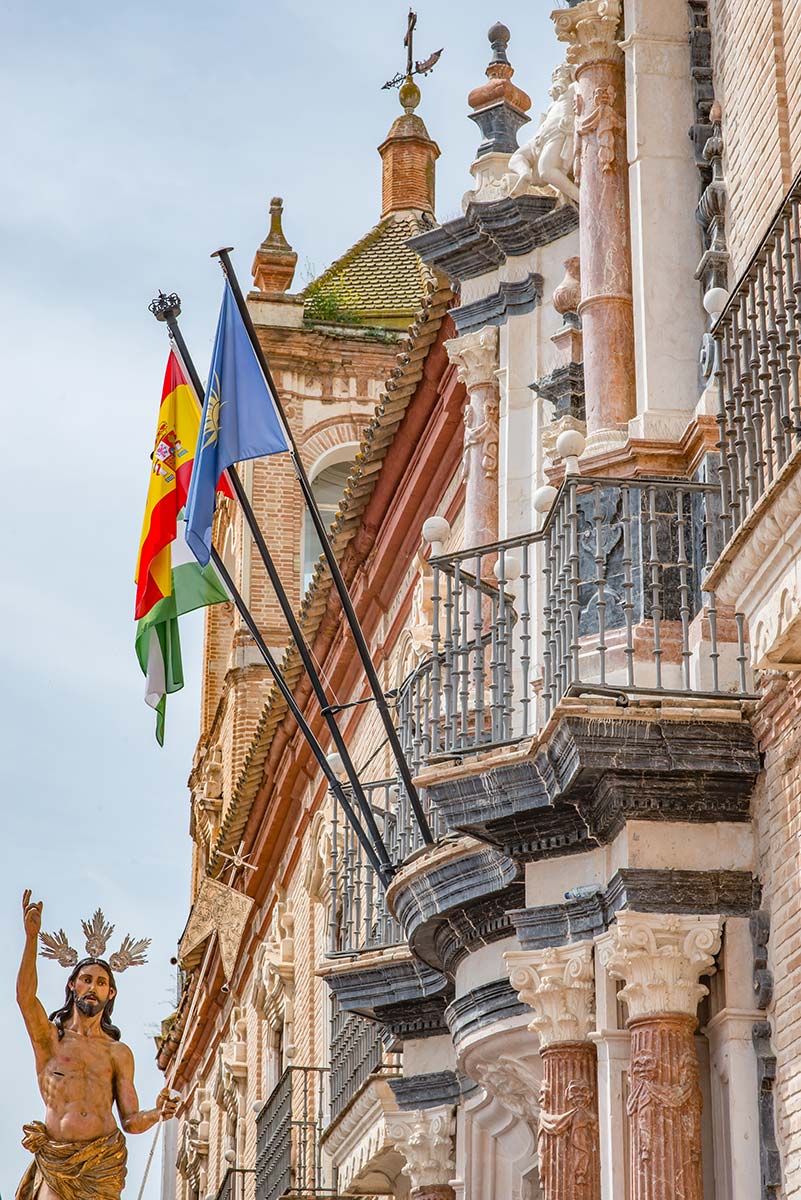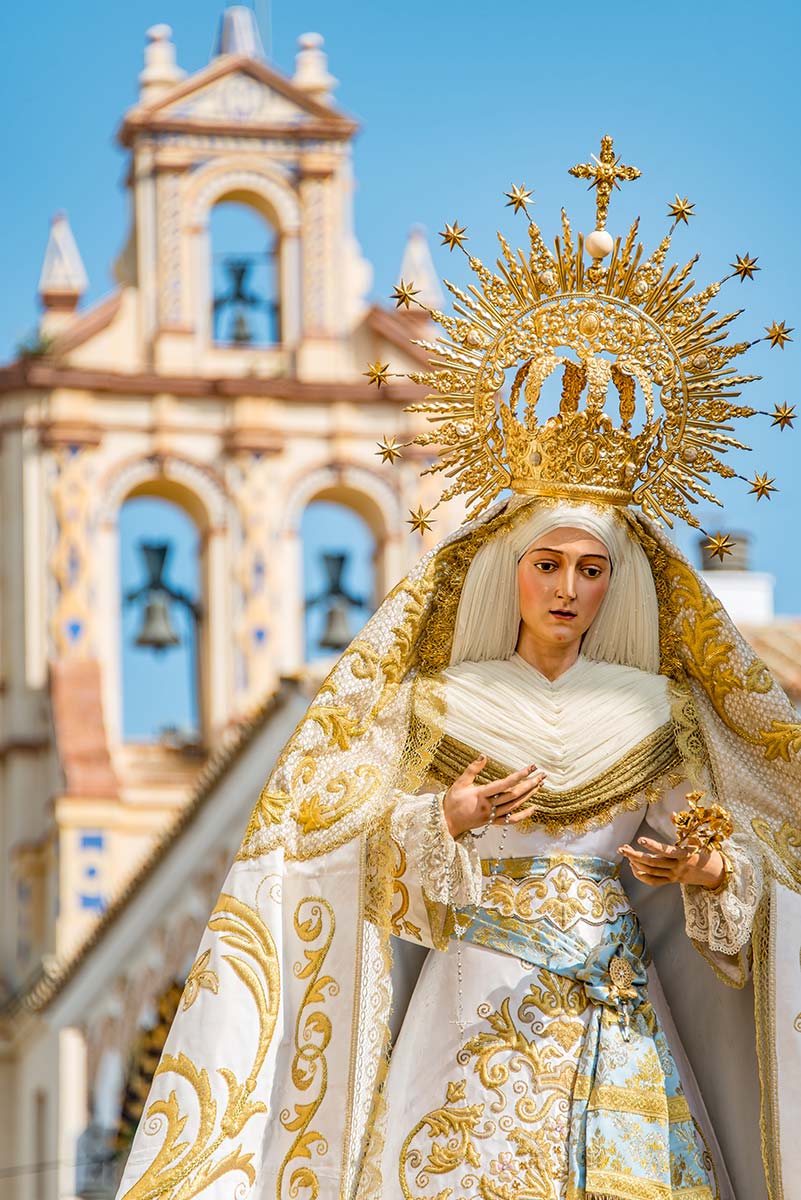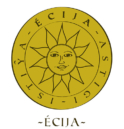hOLY WEEK IN ÉCIJA…
Écija’s most important festivity is Holy Week, declared a National Festival of Interest to Tourists. Each year, people from Écija and tourists from all over the world come to visit it, eager to see the religious statues on the processional pasos1. Among them we must mention the Cristo de la Salud, which dates back to 1500; the Cristo de la Yedra, dating from 1600 and crafted by Juan de Mesa; the Cristo de la Expiración, from 1729 and made by Montes de Oca; the Cristo de la Sangre, made by Gaspar del Águila in 1567 or the Santo Entierro, whose wooden urn is covered by fine tortoiseshell engravings with pure silver inlaid works, crafted in 1711.
In the following lines we provide you with further information about Holy Week, offered by the Consejo General de Hermandades y Cofradías Ciudad de Écija.
Consejo General de Hermandades y Cofradías de la Ciudad de Écija
Location and contact: Post Office Box 208 – 41400 Écija (Sevilla) – Telephone numbers: +34 955 904 197 / +34 650 404 604 – www.consejohermandadesecija.org
Name of the Order: Ilustre y Fervorosa Hermandad y Cofradía de Nazarenos de la Sagrada Entrada Triunfal de Jesús en Jerusalén, Nuestro Padre Jesús Cautivo y Nuestra Madre y Señora de las Lágrimas y Santa María en su Inmaculada Concepción. Church of Santa María
Information: Foundation of the Order: 1955
PROCESSION: LA BORRIQUITA
PASO DE DE LA ENTRADA DE JESÚS EN JERUSALÉN
The Holy Image of Jesus triumphantly entering Jerusalem is the work of the Sevillian artist Álvarez Duarte (1974). “La Borriquita” is the work of Francisco Fernández Enríquez, from Seville (2000). The canastilla of the float combines the wood carving of its colour with silver-plated metal applications, the work of the workshops of the Hijos de Juan Fernández, from Seville. The embroidery of the skirts and vents is the work of the artist Jesús Rosado Borja from Ecija. Nazarenes’ tunic: Black, white cape, white hood and esparto grass cincture. Costaleros: 35.

PROCESSION: NUESTRO PADRE JESÚS CAUTIVO Y SEÑORA DE LAS LÁGRIMAS
PASO DE NUESTRO PADRE JESÚS CAUTIVO
The titular image of this brotherhood is a masterpiece by the Sevillian sculptor Cayetano González, from 1947. Its special feature is the Crown of Thorns, which the artist wanted to sculpt on the Holy Image of Jesus, still in captivity. The baroque style paso, with carving by Antonio Martín, was gilded by José Luis Asencio. It is currently being restored by the gilder Miguel Santana Morato, from Seville. The image was restored in 1998 by the Sevillian sculptor Francisco Fernández Enríquez.
Nazarenes’ tunic: Black, white cape, black hood and esparto grass cincture. Costaleros: 35.
PASO DE NUESTRA SEÑORA DE LAS LÁGRIMAS
Our Lady of Tears is carried in a procession on a canopy of embroidered canopy on “burgundy” coloured velvet, the work of José Luis Asencio. The canopy has an oval painting by Rafael Amadeo Rojas. The gold work of the paso is the work of the workshops of the Hijos de Juan Fernández, and the set of pitchers by Villareal. The image is by an anonymous 18th century artist.
Nazarenes’ tunic: Black, white cape, white hood and esparto grass cincture. Costaleros: 30.

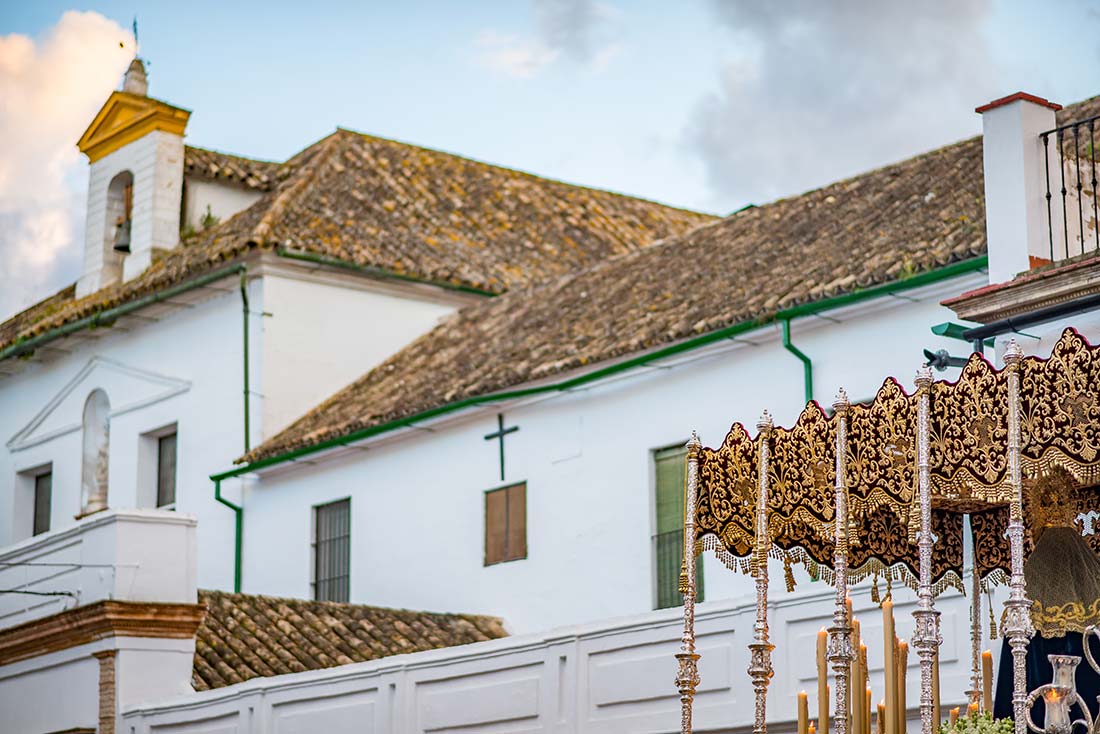
Name of the Order: Agrupación Parroquial de Nuestro Padre Jesús del Amor en su Prendimiento y María Santísima de la Concepción. Chapel of Santa Ángela de la Cruz.
Information: Foundation of the Order: 2017
PROCESSION: EL OLIVO
PASO DE NUESTRO PADRE JESÚS DEL AMOR EN SU PRENDIMIENTO
The image of Our Father Jesus of Love (2011) is the work of Juan Manuel Miñarro, and is the first image of Christ, still alive, executed by this artist based on his anatomical-forensic studies of the Shroud of Turin. The image represents the moment when Jesus hands himself over to the Jewish guard in the Garden of Olives. Tunic of the body of Nazarenes: White tunic and hood. Esparto grass sash and hazel sandals with white socks.

Name of the Order: Fervorosa Hermandad del Santísimo Cristo de la Yedra y Nuestra Señora de la Caridad. Church of Santa Ana.
Information: Foundation of the Order: 1959
PROCESSION: LA YEDRA
PASO DEL SANTÍSIMO CRISTO DE LA YEDRA
The Holy Image of the Christ of La Yedra, which is venerated in the old convent of the Franciscan Third Order (Santa Ana), in the popular district of El Puente, is a work attributed to Juan de Mesa, from around 1630. It is carried in a Baroque style procession with windshield candelabra, carved by Antonio Martín and gilded by Ángel de la Feria.
Nazarenes’ tunic: green hood and tunic and white cape. Costaleros: 29.
PASO DE NUESTRA SEÑORA DE LA CARIDAD
Santísima Virgen de la Caridad is a carving by the sculptor Francisco Buiza Fernández, from 1961. It is a Sevillian style sorrowful Virgin who made her first penitential procession in 1962 on the float on which Our Lady of the Valley was paraded. With time, the Brotherhood was able to afford a Sevillian style paso de palio, whose gold and silver work was made in the workshops of Juan Fernández. The embroidery of the banners, canopy roof and mantle was done by José Luis Asencio.
Nazarenes’ tunic: green hood and tunic and white cloak. Costaleros: 30.


Name of the Order: Hermandad del Santísimo Cristo de la Expiración, Nuestra Señora de los Dolores y Nuestro Padre Jesús Nazareno de la Misericordia (also called “Order of the Students”). Church of Santiago el Mayor.
Information: Foundation of the Order: 1579
PROCESsIoN: LA expiración
PASO DE NUESTRO PADRE JESÚS DE LA MISERICORDIA
This paso represents the mystery of the Gospel passage of the Denials and Tears of St. Peter. The image of Jesús Nazareno de la Misericordia is a carving by Montes de Oca (18th century) and was carried in procession with the Brotherhood in 1833, being reincorporated again on 27th October 1996. The structure of the float and its basket, built by the Ecijan workshop of Antonio Balmaseda Rodríguez e Hijos, and its carving, once completely finished, will be in the purest Ecijan baroque style, designed by Rafael Amadeo Rojas. The image, that of Saint John the Evangelist, a masterpiece by the same author.
Tunic of the body of nazarenes: white cloak and tunic; white hood. Costaleros: 45.
PASO DEL SANTÍSIMO CRISTO DE LA EXPIRACIÓN
Santísimo Cristo de la Expiración is a masterpiece by Pedro Roldán (17th century). Restored in 1991 by José Rodríguez-Rivero Carrera. The paso is the work of the cabinetmaker J. Belmonte (1965), carved by Antonio Martín and reliefs with scenes of the Passion by A. Borrego with polychromy by J. Ojeda. The four Evangelists are by Rafael Amadeo Rojas. The embroidered skirts and vents on red velvet are the design of José L. Asencio.
Tunic of the body of Nazarenes: white cloak and tunic; red hood. Costaleros: 35.
PASO DE NUESTRA SEÑORA DE LOS DOLORES
Attributed to La Roldana in 1713 and restored in 1991 by José Rodríguez-Rivero Carrera. Step inspired by the Ecijan Baroque style in silver plated metal by Díaz Roncero, and wood in its colour by Moreno Anguita. The burst, heart and crescent in sterling silver from the punches of Franco (17th century) and the crown is also in silver, apparently by the same goldsmith. The embroidery on the cloak is by J. Ojeda.
Tunic of the Nazarene corps: White cloak and tunic; purple hood. Costaleros: 35.



Name of the Order: Sacramental y Real Archicofradía de Nazarenos de la Coronación de Espinas de Nuestro Señor Jesucristo, San Marcos, San Roque, Santísimo Cristo de la Salud, Nuestra Señora de los Dolores, Sagrado Corazón de Jesús y San Juan de Dios. Church of San Gil.
Information: Foundation of the Order: 1563
PROCESSIoN: SAN GIL
PASO DEL MISTERIO DE LA CORONACIÓN DE ESPINAS DE NUESTRO SEÑOR JESUCRISTO
The Holy Image comes from an Ecce Homo (18th century) by an anonymous author. In 1991 it was restored and reformed by Rafael Amadeo Rojas, who made new legs. The figures accompanying the Coronation are the work of Rafael Amadeo Rojas (1992-1998). Cedar wood carving from the workshops of the Sevillian Antonio Díaz (1991). Candelabra of windshields. In the corners, the four evangelists are the work of the Sevillian Antonio Castillo Lastrucci (1959).
Tunic of the Nazarene corps: Purple with white buttons and a purple sash. White cloak with purple laps. Passion coat of arms on a purple background embroidered on the left shoulder. Short hood covered by a purple hood with shield. Black gloves. Costaleros: 45.
PASO DEL SANTÍSIMO CRISTO DE LA SALUD
The very devout image of the Cristo de la Salud can be dated to the end of the Andalusian Gothic period, around the year 1500 approximately. The sculpture is life-size. Restored by Luis Álvarez Duarte in 1985, it is carried in a superb procession in a superb neo-baroque style, in mahogany wood of Guinea in its colour (1969), illuminated by four thick torches at its corners. Appliqués of sterling silver. On the skirts, brooches embroidered in fine gold.
Tunic of the Nazarene corps: Purple with white buttons, purple sash. White cloak with purple laps. Passion coat of arms on a purple background embroidered on the left shoulder. Short hood covered by a purple hood with shield. Black gloves. Costaleros: 35.
PASO DE NUESTRA SEÑORA DE LOS DOLORES
The Santísima Virgen de los Dolores is by José Montes de Oca, at the end of the 17th century. Restored by Luis Álvarez Duarte in 1985. The canopy, whose gold work is from the workshops of Hijos de Juan Fernández from Seville, made between 1969 and 1977. The crown is by Manuel de los Ríos also from Seville (1982). Blue velvet mantle, embroidered in fine gold by Ana Antúnez (1882). The canopy roof is embroidered in gold.
Tunic of the Nazarene corps: White with light blue buttons, with a light blue sash. White cloak with light blue laps. Passion coat of arms on a light blue background embroidered on the left shoulder. Short hood covered by a light blue hood with coat of arms. White gloves. Costaleros: 35.
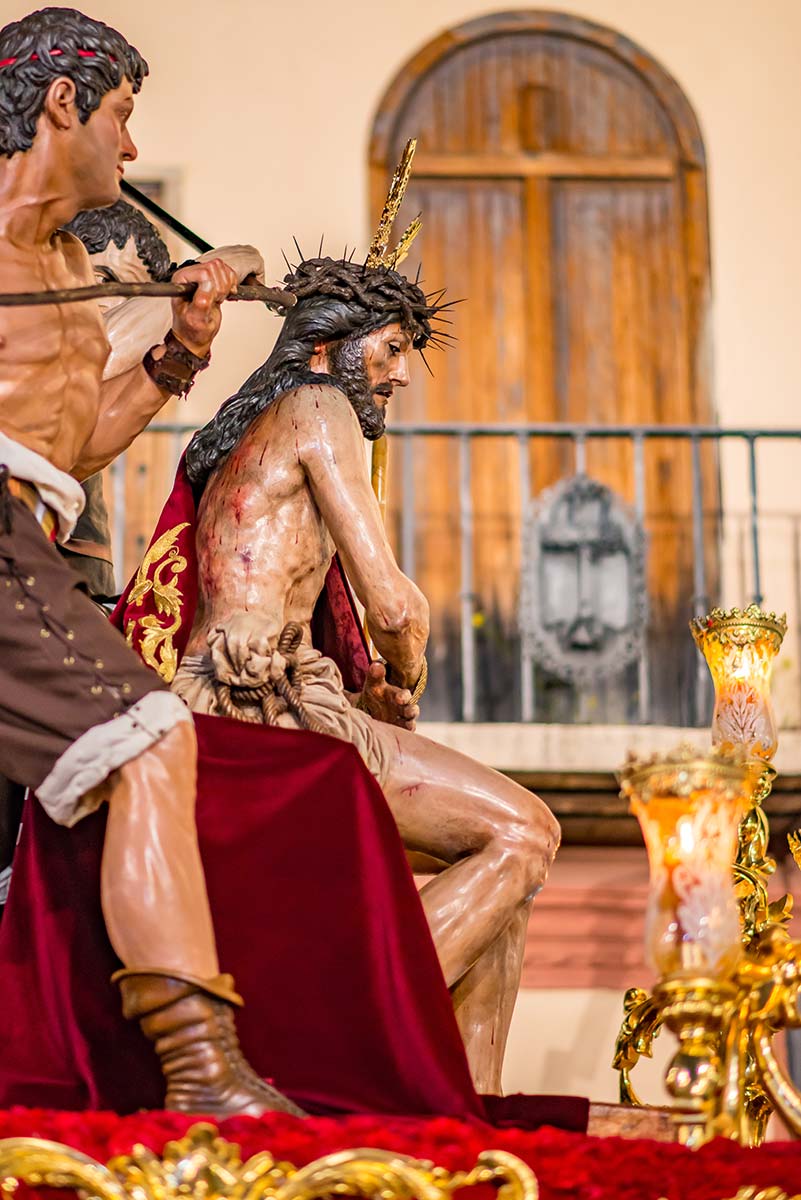

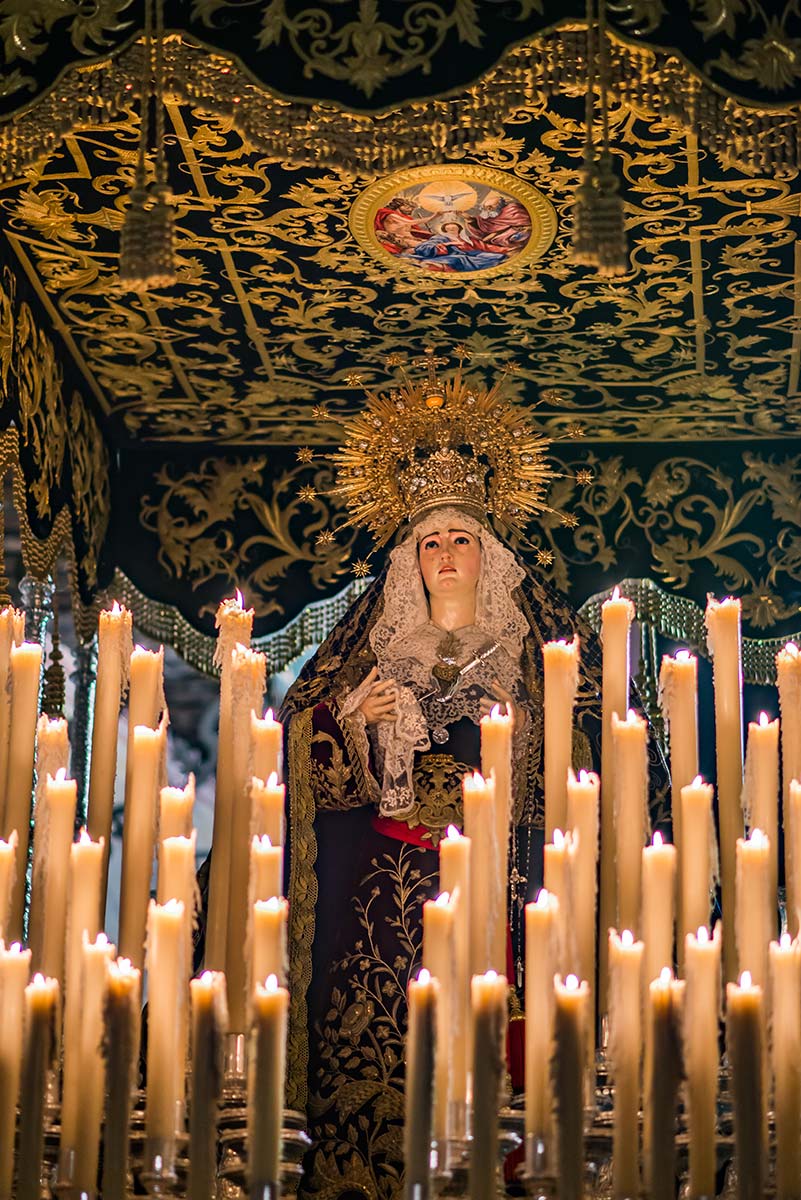
Name of the Order: Real y Fervorosa Hermandad y Cofradía de Penitencia del Bienaventurado San Francisco de Paula, Santísimo Cristo de la Sagrada Columna y Azotes, Santísimo Cristo de Confalón, Nuestra Señora de la Esperanza y de la Purísima Concepción de María. Church of La Victoria.
Information: Foundation of the Order: 1570
PROCESsIoN: EL CONFALÓN
PASO DEL SANTÍSIMO CRISTO EN EL MISTERIO DE LA SAGRADA COLUMNA Y AZOTES
The Holy Image of Christ in the Mystery of the Scourging on the Column (16th century), by an anonymous author, was restored between 1999-2000. It is carried in a carved, gilded and polychrome rococo style procession by Pérez Calvo (1940). The mystery is completed by two sayons and a Roman centurion by Rafael A. Rojas (1995).
Tunic of the Nazarene corps: White, red velvet sash with a coat of arms on it. Costaleros: 35.
PASO DEL SANTÍSIMO CRISTO DE CONFALÓN
The venerated image of the Santísimo Cristo de Confalón (16th century), by an anonymous author, is of Renaissance style with Gothic influences and was restored in 2000. It is nailed to an ebonised cross with mother-of-pearl, ivory and tortoiseshell inlay. It is carried in procession in the purest Ecijan style, (carried on the shoulders of its brothers in two rows) with a gilded 18th century Baroque pedestal. It is illuminated with candelabras of fine gold gilt metal, and a windshield with rock crystal teardrops.
Tunic of the Nazarene corps: White, black velvet sash and coat of arms on it. Costaleros: 32.
PASO DE NUESTRA SEÑORA DE LA ESPERANZA
The Virgen de la Esperanza, by an anonymous author and restored between 1997-1998, is carried in procession on a magnificent paso de palio. The embroidery of gold tissue “cut-outs” on green velvet in harmonious conjunction with the mantle is the work of José Luis Asencio. The Passionist paintings on the inside of the banners are also worthy of note. Gold and silver work by Villareal.
Tunic of the body of nazarenes: White, green velvet sash and coat of arms on it. Costaleros: 30.


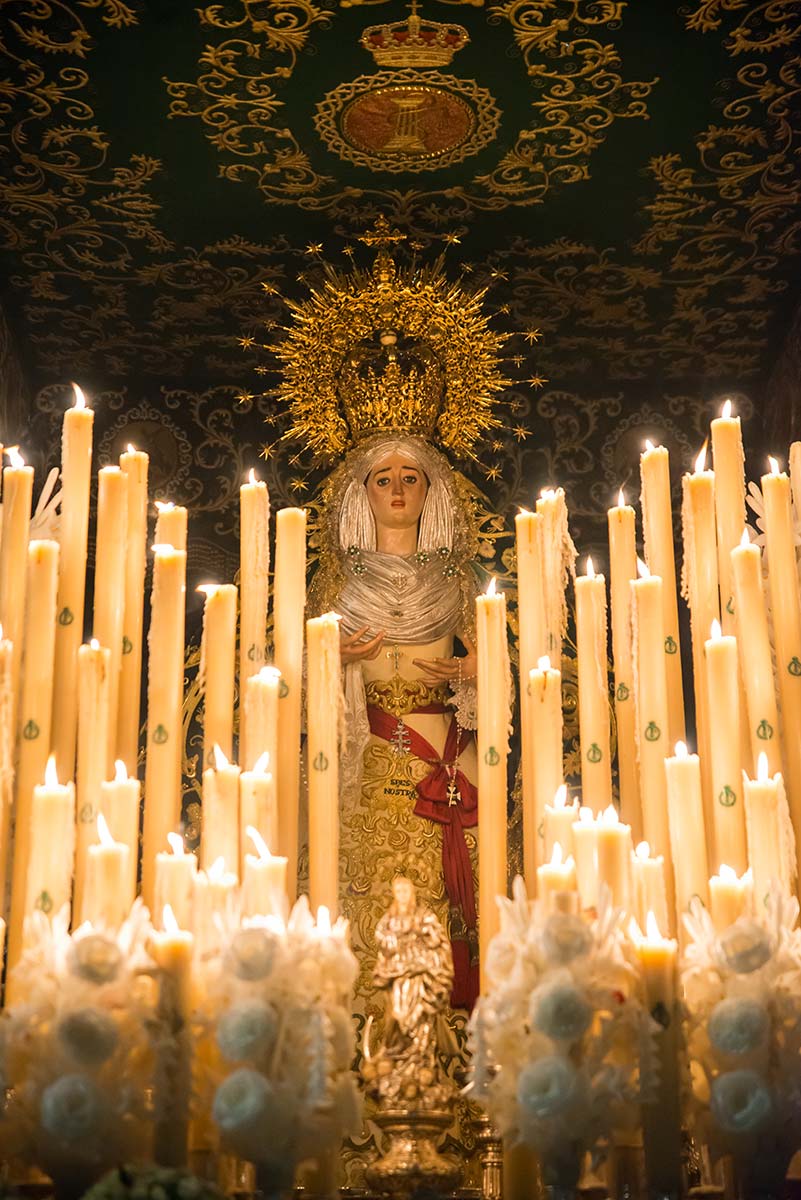
NAME OF THE ORDER: Real, Muy Antigua y Fervorosa Hermandad del Santísimo Cristo de la Sangre y Nuestra Señora de los Dolores. Parroquia Mayor de Santa Cruz..
Information: Foundation of the Order: 1564.
PROCESSIoN: LA SANGRE
PASO DEL SANTÍSIMO CRISTO DE LA SANGRE
The Holy Image of the Holy Christ of the Blood is a masterpiece by Gaspar del Águila (1567) in Renaissance style, inspired by that of St. Augustine of Seville. Its rules were approved in 1571, and it has been in procession for seven years. It is carried in a Baroque procession designed by José Belmonte from Ecija, carved by Antonio Martín and gilded by Antonio Díaz (both from Seville). On the corners it has candelabra and evangelists.
Tunic of the Nazarene corps: Red with white cloak and esparto grass cincture. Costaleros: 35.
PASO DE LA SANTÍSIMA VIRGEN DE LOS DOLORES
The Virgen de los Dolores is by the sculptor Antonio Poz, from Cordoba (1853). The gold and silver work on the canopy is by Villareal. The embroidery on maroon velvet on the canopy and purple on the mantle are enriched with 18th century embroidery. On the front there is an image of Saint Augustine in sterling silver.
Tunic of the Nazarene corps: Tunic: White with red cape and red esparto grass cincture. Costaleros: 35.
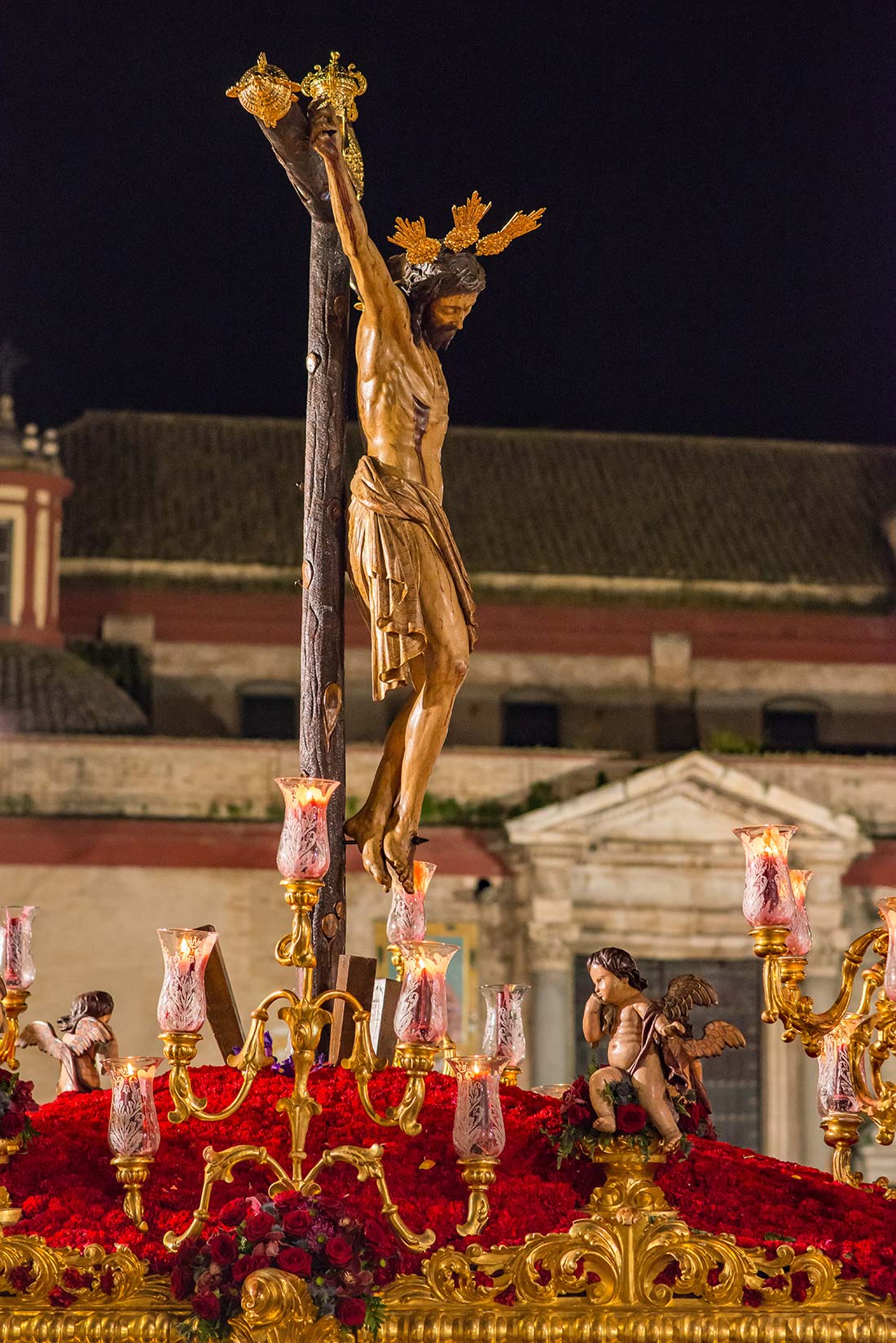
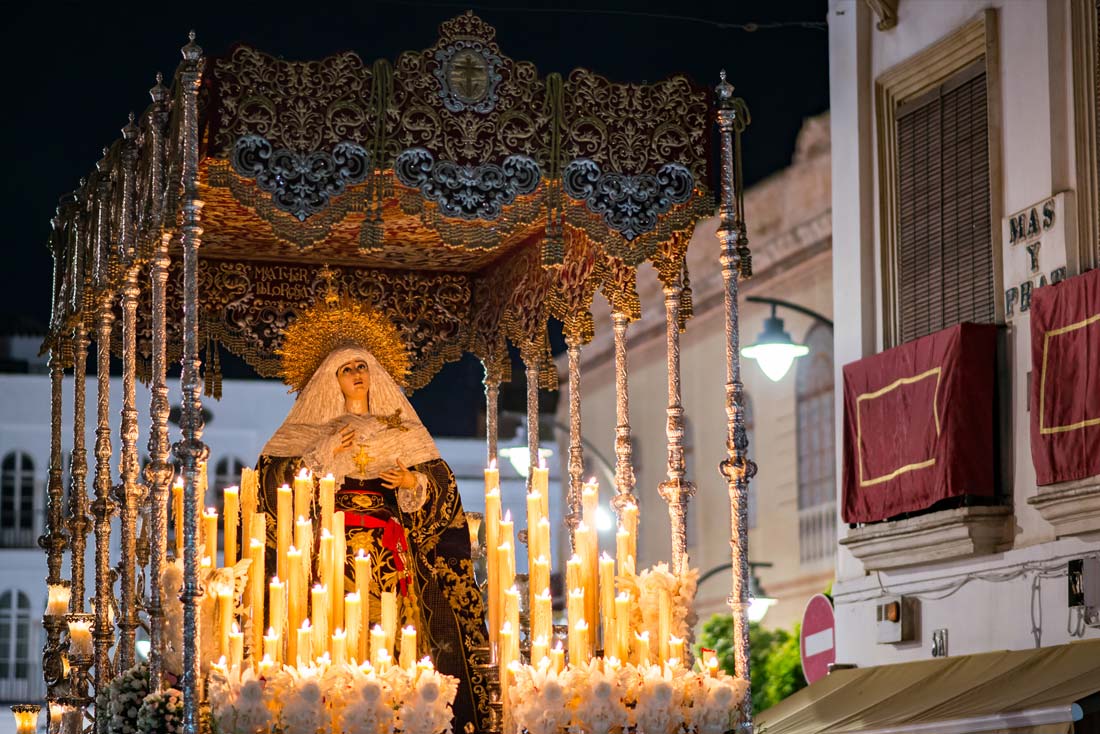
NAME OF THE ORDER: Real y Venerable Hermandad y Confradía de Nazarenos de Nuestro Padre Jesús Nazareno Abrazado a la Cruz y María Santísima de la Amargura. El Silencio. Parroquia Mayor de Santa Cruz.
Information: Foundation of the Order: 1666
PROCESSIoN: EL SILENCIO
PASO DE NUESTRO PADRE JESÚS NAZARENO ABRAZADO A LA CRUZ
The miraculous image of Jesus Embraced with his Cross is attributed to the famous sculptor Pedro Roldán (17th century). Its Baroque cross is made of sterling silver (17th century) enlarged by Villareal following his original design. The pendants, also of sterling silver (18th century) are probably rococo by Damián de Castro. It wears a tunic with rich gold embroidery on purple velvet in the same style as the cross (18th century). It processes in a severe Baroque paso, made of wood carved in its own colour, carved by Francisco Palos, from Puente Genil, which is completed with ten lanterns and silver medallions, all from the workshop of Villareal (Seville).
Tunic of the body of Nazarenes: Purple, black cloak and cape, esparto grass cincture; black shoes. Costaleros: 30.
PASO DE MARÍA SANTÍSIMA DE LA AMARGURA
The Santísima Virgen de la Amargura, the work of Antonio Castillo Lastruccí (1964). Seville style canopy, embroidered in gold and silver, the work of the artist Joaquín Ojeda from Ecija. The beams are made by Angula and the candelabra by Villareal.
Tunic of the Nazarene: Same as those of the Nazarene. Costaleros: 30.
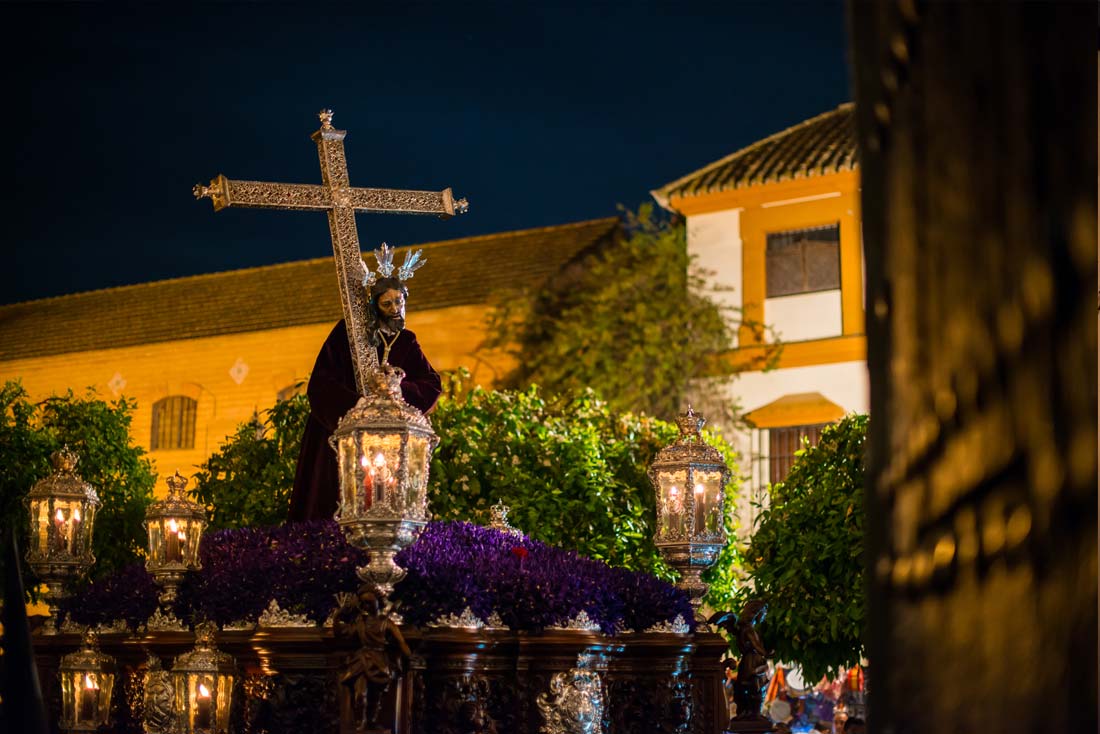

NAME OF THE ORDER: Pontificia, Ilustre y Muy Antigua Hermandad y Confradía de Nuestro Padre Jesús Nazareno, Santa Cruz en Jerusalén, María Santísima de las Misericordias y San Juan Evangelista y San Francisco de Écija. Iglesia de San Juan.
Information: Foundation of the Order: 1959
PROCESSION: SAN JUAN
PASO DE NUESTRO PADRE JESÚS NAZARENO
The Holy Image of Jesus of Nazareth on the road to Calvary is from the Sevillian school of the 17th century, author unknown; restored in the 1960s by Francisco Buiza and Joaquín Ojeda. It is carried in a procession with a Baroque canastilla reformed by Antonio Martín. Lanterns of gilded metal from Villareal. The four evangelists are by Ricardo Comas and the purple damask skirts are designed and embroidered by Joaquín Ojeda.
Tunic of the body of Nazarenes: Black with cape gathered in the sash, black hood; the cross of Jerusalem in red. Costaleros: 35.
PASO DE NUESTRA SEÑORA DE LAS MISERICORDIAS
The Virgin of Mercy accompanied by Saint John, the work of Ricardo Comas, in the Sevillian style. The image of Saint John is by the same artist and in the same style. The complete gold and silver work of the magnificent paso de palio is the work of Villareal. The blue velvet mantle with gold embroidery is by the Sevillian Juan Manuel Rodríguez Ojeda. The gold-embroidered baldachins on maroon velvet are the design of Joaquín Ojeda and the canopy with 18th century embroidery on maroon velvet has a silver medallion with the coronation of the Blessed Virgin embroidered in gold and silk.
Tunic of the body of Nazarenes: Same as those of the Nazarene. Costaleros: 30.
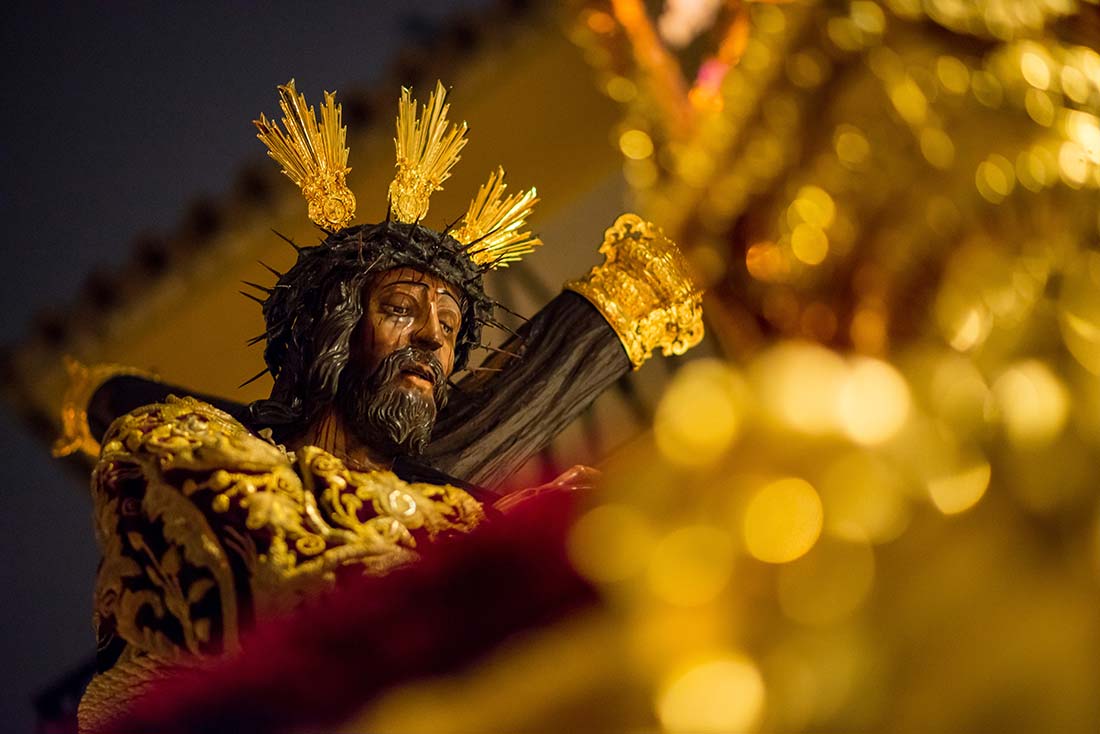

Name of the order: Hermandad y Confradía de Nuestro Padre Jesús Sin Soga, Nuestra Señora de la Fe y Sagrados Corazones de Jesús y María. Iglesia de Santa Bárbara.
Information: Foundation of the Order: 1977
PROCESSIoN: JESÚS SIN SOGA
PASO DEL SANTÍSIMO CRISTO DE LA EXALTACIÓN EN LA CRUZ
The Image of Christ is the work of Miguel de Vilches, from Ecija, from 1597, in Mannerist style; it was restored in 1992. The mystery is completed with two Roman figures carved in 1959 by Guillermo Riego and a “sayón” restored by Rafael Amadeo Rojas. The canastilla is an 18th century Ecijan work, in Baroque style, completely gilded, with golden candelabra and four Passionist images in the corners. The procession is carried in the old style, in the manner of the “andas” by costalero brothers.
Tunic of the body of Nazarenes: white, black hood, black cape, black shoes and gloves, black sash. Costaleros: 35.
PASO DE NUESTRA SEÑORA DE LA PIEDAD
The ancient and devout image of the Virgen de la Piedad is by an anonymous author, possibly from the 16th century, and was restored by Ricardo Comas in 1992. The Virgin is accompanied by Saint John the Evangelist, restored by Rafael Amadeo Rojas. It was donated by Fray José de la Escalera Fernández de Córdoba in 1751. The Virgin is accompanied every two years by Saint John the Evangelist, from the 19th century. The gold work is by Villareal and the candelabra by Hermanos Fernández. The gold and silver embroidery, both on the mantle and on the ceiling and the canopy of the canopy, is the work of J. Ojeda.
Tunic of the Nazarenes: White with black hood, black cape, black shoes and gloves, black sash. Costaleros: 30.
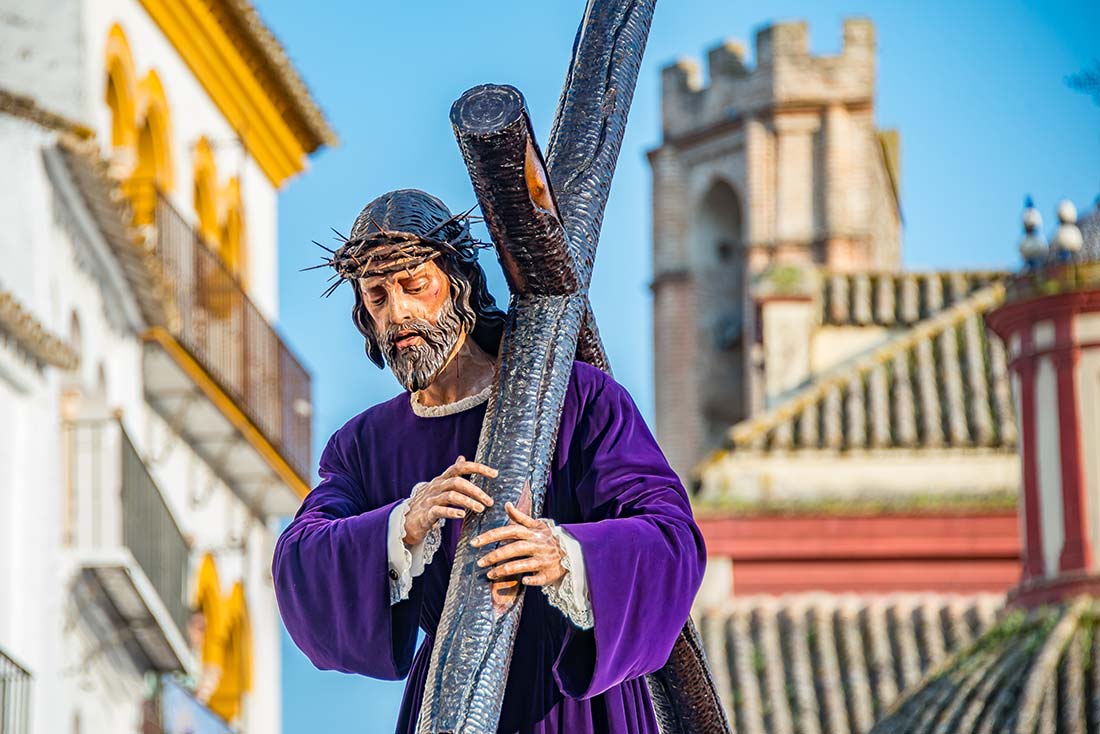

NAME OF THE ORDER: Real, Muy Antigua y Fervorosa Hermandad de Nuestra Señora de la Piedad y Santísimo Cristo de la Exaltación en la Cruz. Iglesia Conventual de la Merced.
Information: Foundation of the Order: 1509.
PROCESSIoN: LA PIEDAD
PASO DE NUESTRO PADRE JESÚS SIN SOGA
The invocation comes from a legendary tradition by which the Venerable Image of the canvas of the exterior chapel of the Church of Santa Bárbara, by which Jesus gave his cincture to a needy man, turning it from esparto grass into gold so that with the money, he could cure his sick wife. The carving of Jesus is the work of José Montes de Oca dated 1733 and comes from the old Convent of San Gregorio. This image is carried in procession carrying a cross, without a cincture, on a neo-baroque step carved in wood in its dark colour with gilded cartouches, cresting, mouldings and golden hachons.
Tunic of the body of Nazarenes: White tunic without cincture, white bonnet without hood and the coat of arms of the brotherhood in the centre. Dark shoes. Costaleros: 35.
PASO DE NUESTRA SEÑORA DE LA FE
The Virgen de la Fe is an anonymous work from the 17th century that comes from the Convent of San Pablo and Santo Domingo and during the 17th and 18th century it was part of the procession of the now disappeared Brotherhood of Cristo Yacente of the aforementioned convent. Now it is carried in a procession with a carving by Francisco Palos from the 80s of the last century.
Tunic of the body of nazarenes: White tunic without cincture, white hood without cardigan and the brotherhood’s coat of arms in the centre. Dark shoes. Costaleros: 30.
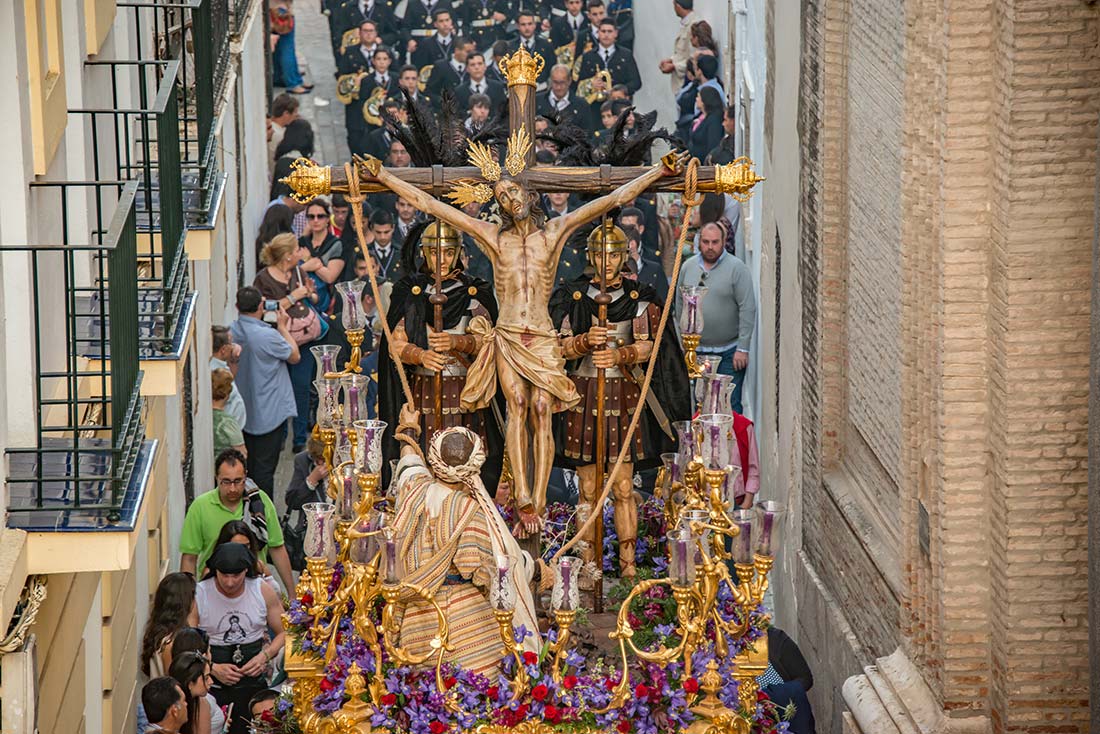
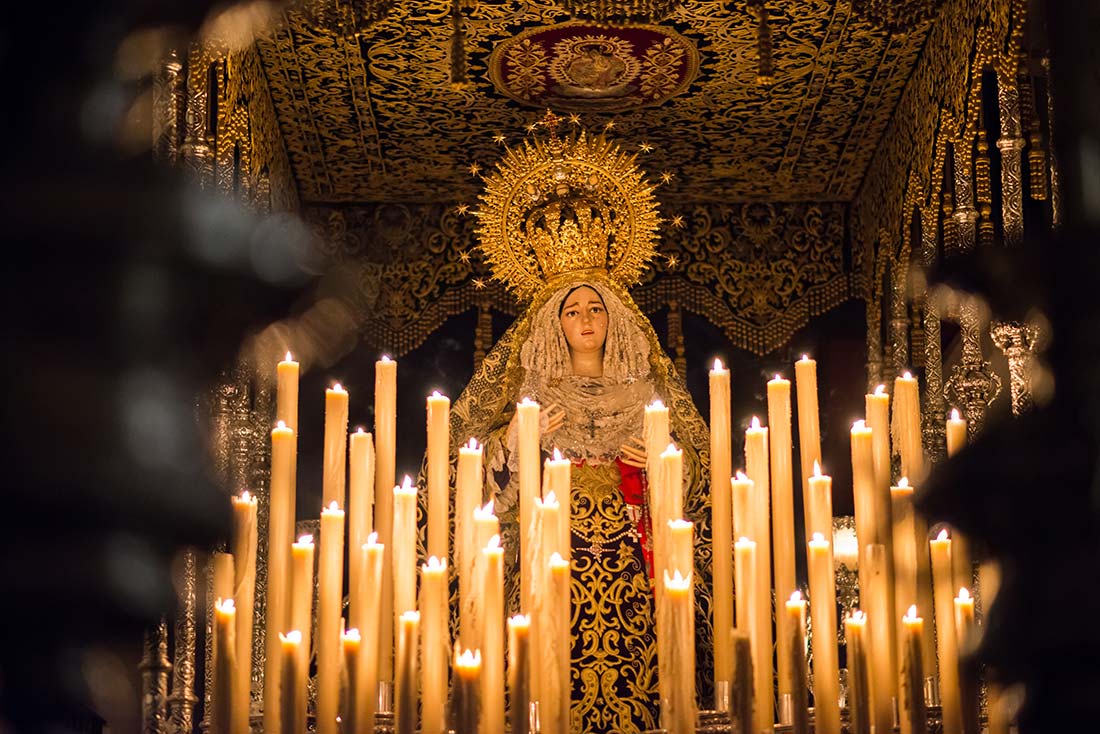
NAME OF THE ORDER: Sacramental de Nuestra Señora del Carmen, Confradía de Nazarenos de Santísimo Cristo de la Misericordia, Nuestro Padre Jesús Descendido de la Cruz en el Misterio de su Sagrada Mortaja y María Santísima de la Piedad. Iglesia de los Descalzos.
Information: Foundation of the Order: 1989.
PROCESSIoN: LA MORTAJA
PASO DE LA SAGRADA MORTAJA
The image of Nuestra Señora de la Piedad, an anonymous sorrowful image from the 18th century, restored in 1991 by D. Manuel Ramos Corona, the image representing María Salome was the Dolorosa that had been in procession since the 17th century, as well as the image of María la de Cleofas, which was also a Dolorosa. San Juan Evangelista is by the Sevillian sculptor Fernando Murciano Abad, made in 1998. The design and carving of the paso is by the Sevillian carver Pedro Manuel Benítez Corrión.
Tunic of the body of the Nazarenes: Brown, with Carmelite scapular. Cream coloured hood with the Brotherhood’s coat of arms. Costaleros: 35.
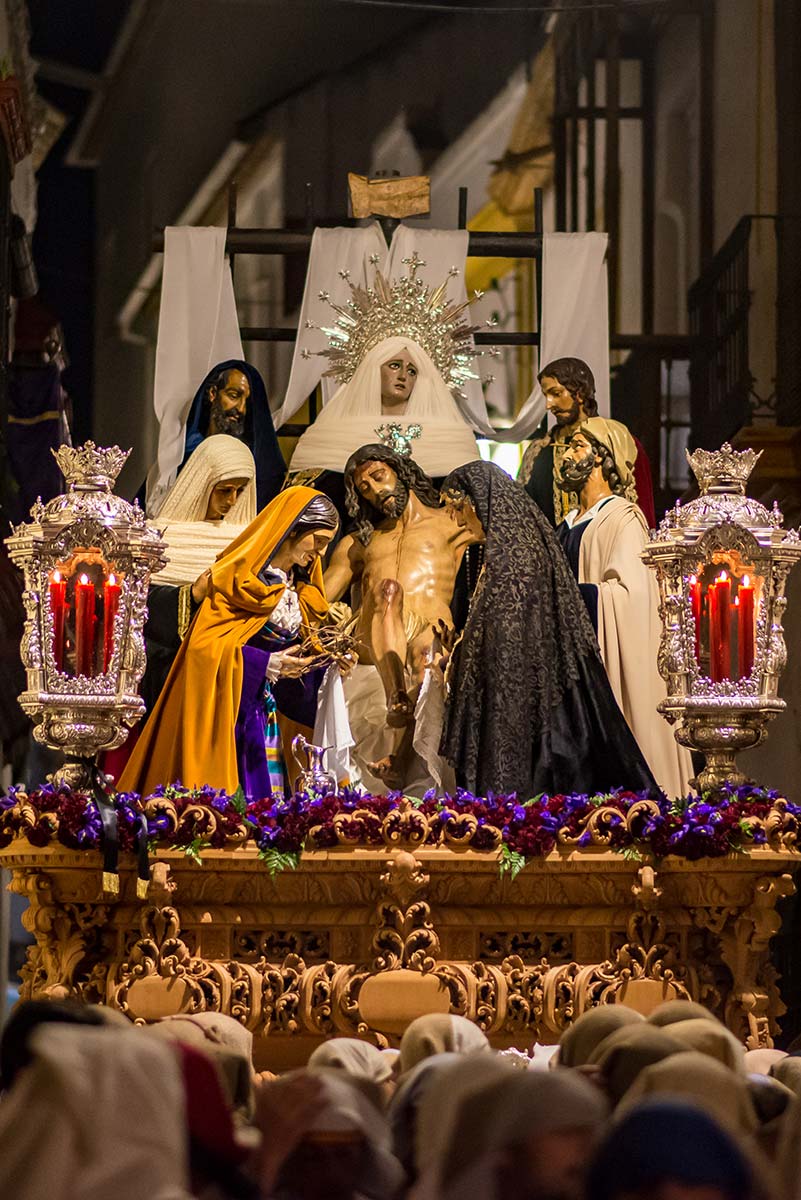
name of the order: Real, Muy Ilustre, Antigua y Noble Confradía de Nazarenos de Nuestra Señora en la Consideración de sus Angustias y Soledad, Santo Entierro de Nuestro Señor Jesucristo y del Dulce Nombre de Jesús. Parroquia de Nuestra Señora del Carmen.
Information: Foundation of the Order: 1492
PROCESSIoN: EL SANTO ENTIERRO
PASO DE LA QUINTA ANGUSTIA
Step representing the anguish of the Virgin Mary when she gathers in her lap the mortified and lifeless body of OUR Lord Jesus Christ. The figures of this mystery are made of real cedar wood and polychrome. The whole is finished off with a wooden cross covered with tortoiseshell sheets with silver inlays from the 18th century. The carving of the paso, in mahogany wood in its colour, is of baroque style with sterling silver appliqués.
Tunic of the Nazarene corps: White, black cape and black velvet hood with white piping; sash also in black velvet. The cloaks carry the Brotherhood’s coat of arms on the left shoulder. Costaleros: 30.
PASO DEL SANTO ENTIERRO DE NUESTRO SEÑOR JESUCRISTO
The image of Jesus in his Holy Sepulchre is of late Gothic style, between the 14th and 15th centuries, by an unknown author. The sculptor wanted to express the lack of movement typical of corpses, although it conveys a certain tension. The hands are on the lap without resting on it; the legs are bent, supported only by the heels; the face of Christ appears placidly asleep. Restored at the Escuela Superior de Bienes Culturales in Madrid in 1996.
Tunic of the corps of Nazarenes: white, black cloak and black velvet hood with white piping; sash also in black velvet. The cloaks carry the Brotherhood’s coat of arms on the left shoulder. This paso is carried on wheels.
PASO DE NUESTRA SEÑORA DE LA SOLEDAD
It depicts the Virgin Mary all alone, holding in her hands the crown of thorns and the shroud worn by her son, OUR Lord Jesus Christ. It is represented as it appears in verse 1 of chapter 12 of the Apocalypse. The Virgen de la Soledad, a beautiful 18th century Ecijan Dolorosa, a candelabra image, with natural hair, attributed to Luisa Roldán (La Roldana) from the 18th century.
Tunic of the Nazarene corps: White colour, black cloak and black velvet hood with white piping; sash also in black velvet. The cloaks carry the Brotherhood’s coat of arms on the left shoulder. Costaleros: 35.
Nazarene corps tunic: White tunic, black cape and black velvet hood with white piping. Black velvet sash. The capes carry the Brotherhood’s coat of arms on the left shoulder.
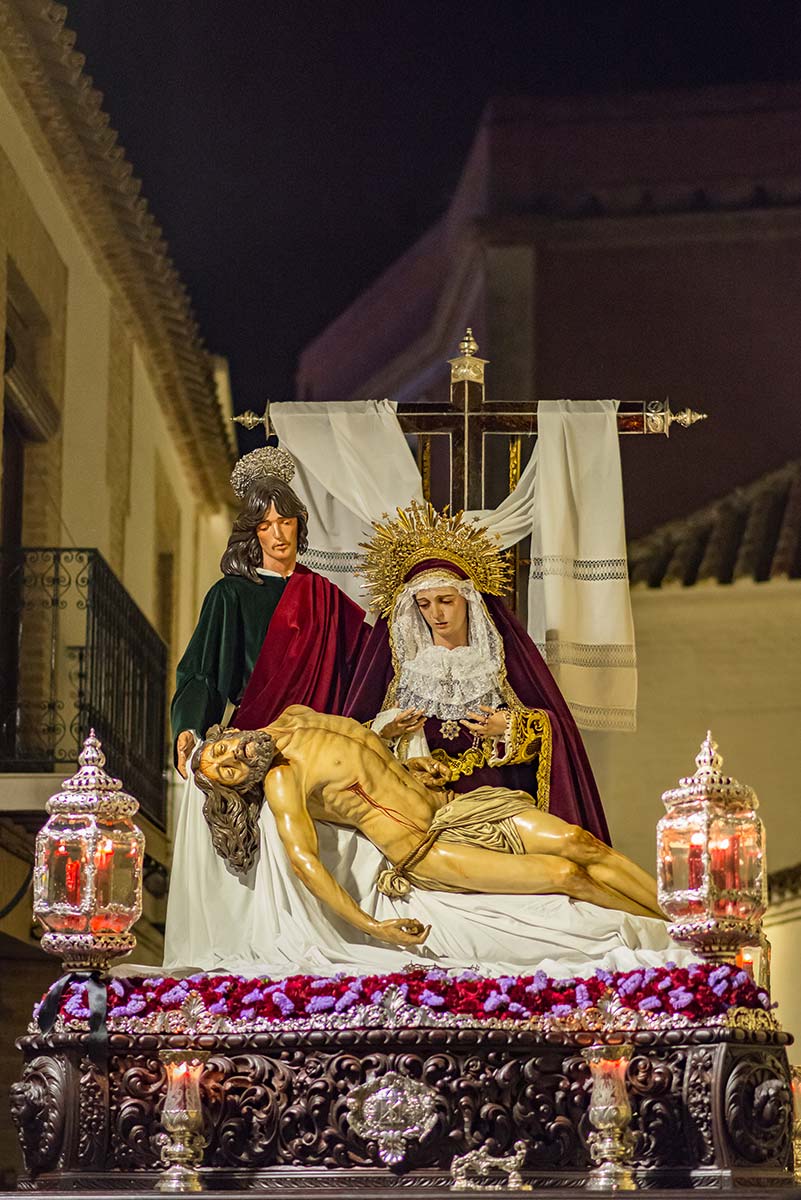
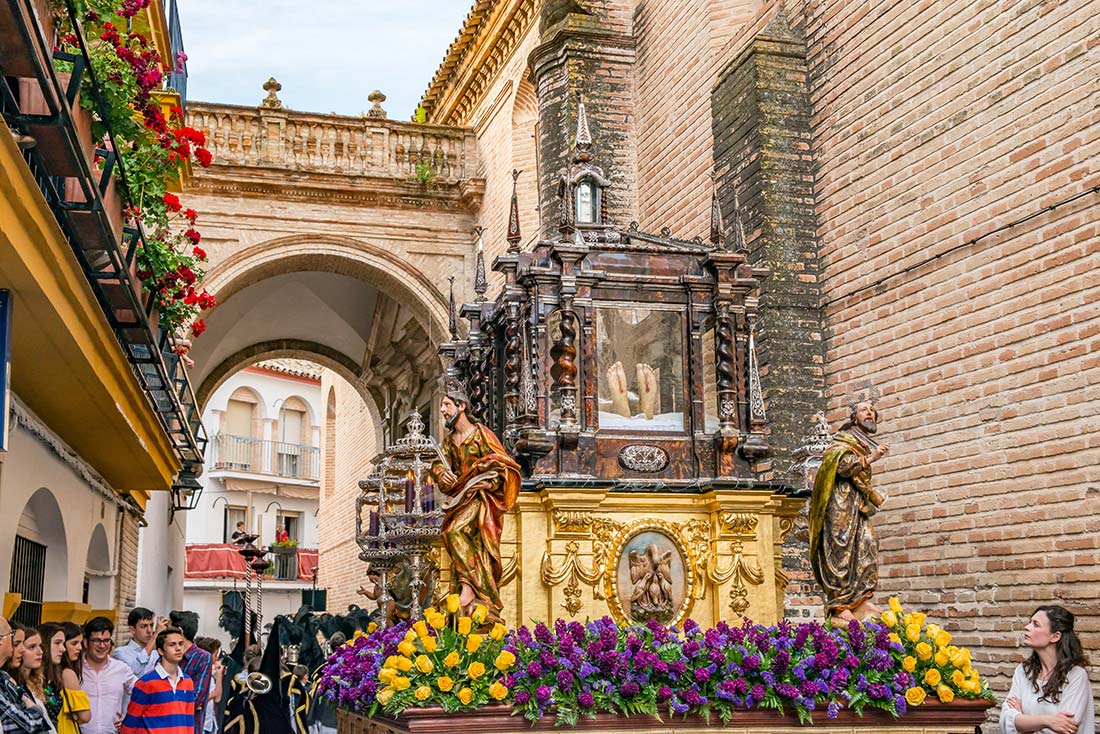

name of the order: del Santísimo Sacramento, Gloriosa Resurrección de Nuestro Señor Jesucristo, María Santísima de la Alegría y Santa María Magdalena.
Information: Parroquia de Mayor de Santa Cruz. Foundation of the Order: 1601
PROCESSIoN: EL Resucitado
PASO DEL CRISTO RESUCITADO
The Sacred Image of the Triumph of the Risen Christ is the work of an anonymous author from the 16th century and was restored by Ricardo Comas. Its first rules date back to 1601, and the brotherhood has been linked to the celebration of the Day of the Cross since that year. It has been granted several bulls by His Holiness Gregory XIII (1580), Gregory XIV (1591), Clement VIII (1604) and Paul V (1610). It was re-founded in 1979, maintaining the title of Sacramental and Resurrection. The current rules date from 2 February 1990.
Tunic of the body of Nazarenes: Cream-coloured, white cloak with a red stripe on the left shoulder. Costaleros: 40.
PASO DE LA VIRGEN DE LA ALEGRÍA
The Santísima Virgen de la Alegría, whose paso is carried by costaleras sisters, is the work of the Sevillian sculptor Antonio Dubé de Luque from 1988. The front of the canastilla is made in the workshops of the Andalusian goldsmith Manuel de los Ríos, from Seville.
Tunic of the nazarene corps: Cream-coloured, white cape with a blue stripe on the left shoulder. Costaleras: 35.
